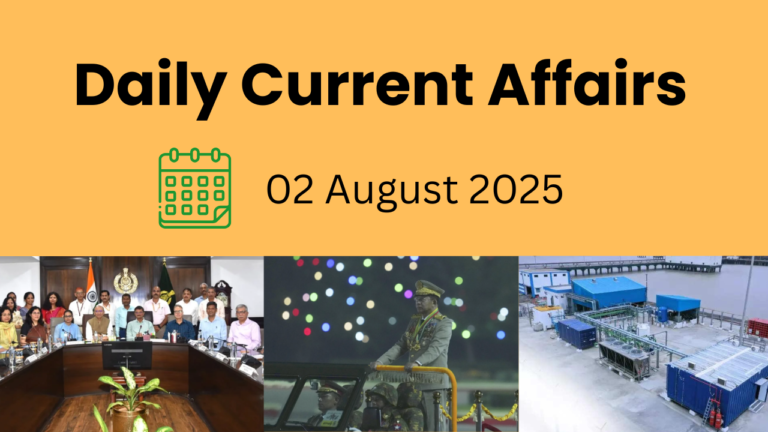1. India-Japan Deepen Strategic Ties with Focus on Key Infrastructure and Regional Cooperation
Context: In a recent high-level meeting, Indian Foreign Secretary Vikram Misri engaged in discussions with senior Japanese officials to further reinforce the Special Strategic and Global Partnership shared between India and Japan. Central to their talks were ongoing and future projects such as the Mumbai-Ahmedabad Shinkansen Bullet Train, highlighting the deepening infrastructure collaboration between the two nations.
Historical Bonds: A Legacy of Friendship
The India-Japan relationship is rooted in centuries-old cultural and civilizational connections. Notably, Indian monk Bodhisena played a historic role in consecrating the Buddha statue at Todaiji Temple in Nara, Japan, in 752 AD. Over the years, many prominent Indian figures have nurtured this bond:
- Swami Vivekananda and Rabindranath Tagore shared intellectual ties with Japanese thinkers.
- Netaji Subhash Chandra Bose and Rash Behari Bose found allies in Japan during India’s freedom struggle.
- Justice Radha Binod Pal remains a revered figure in Japan for his dissenting judgment at the Tokyo War Crimes Tribunal.
- In a symbolic gesture of goodwill, Prime Minister Jawaharlal Nehru gifted an elephant to Tokyo’s Ueno Zoo in 1949 — a gesture fondly remembered in Japan.
Defense and Security Cooperation: A Pillar of Strategic Alignment
The India-Japan defense partnership has gained significant momentum, driven by shared concerns over regional security, especially in the Indo-Pacific. Their Joint Declaration on Security Cooperation (JDSC), signed in 2008, laid the foundation for enhanced strategic alignment.
Key developments include:
- JIMEX: The Japan-India Maritime Exercise, which strengthens naval cooperation between the Indian Navy and Japan Maritime Self-Defense Force (JMSDF).
- Regular dialogues and joint military exercises emphasizing a free, open, and rules-based Indo-Pacific.
Economic Synergy: Trade, Investment & Technology
India and Japan are bound by a Comprehensive Economic Partnership Agreement (CEPA), operational since August 1, 2011. This agreement covers trade in goods and services, investment, intellectual property rights, and customs procedures.
Key trade statistics for FY 2023–24:
- Bilateral Trade: USD 22.85 billion
- Japan’s Exports to India: USD 17.69 billion
- India’s Exports to Japan: USD 5.15 billion
India’s top exports to Japan:
- Organic chemicals
- Automobiles and vehicle parts
- Aluminium
- Marine products
Imports from Japan include:
- Nuclear reactors and machinery
- Electrical equipment
- Iron and steel
- Inorganic chemicals
Japan is a major investor in India, particularly in automobile, infrastructure, and smart city projects. It is also involved in Delhi-Mumbai Industrial Corridor (DMIC) and dedicated freight corridors.
Infrastructure Collaboration: The Shinkansen Project
Japan is set to provide two E-10 series Shinkansen trains to India for the Mumbai-Ahmedabad High-Speed Rail project. Although initially expected to be completed by 2022, the timeline has been revised, with a new completion target of December 2029.
This project will revolutionize travel in India by introducing state-of-the-art high-speed rail technology, reducing travel time between the two commercial hubs to just around 2 hours.
Diversifying Supply Chains: Tackling China Dependency
India and Japan, along with Australia, launched the Supply Chain Resilience Initiative (SCRI) in April 2021, aimed at countering over-reliance on China for critical minerals essential to industries such as electric vehicles (EVs) and semiconductors. The recent India-Japan talks highlighted the urgency of securing alternative sources for such resources.
Focus on Northeast India: Connectivity and Development
The India-Japan Act East Forum, established in December 2017, serves as a platform for collaborative development of India’s North-Eastern region. The forum works on projects related to:
- Connectivity infrastructure
- Industrial development
- Cultural exchanges
- People-to-people contacts
Civil Nuclear Agreement: Enhancing Energy Cooperation
India and Japan signed an Agreement on Peaceful Uses of Nuclear Energy in November 2016, during Prime Minister Narendra Modi’s visit to Japan. This enables Japan to export nuclear technology to India, facilitating cleaner energy development in line with India’s climate goals.
Did You Know?
- Japan was the first country to respond with aid after the 2004 Indian Ocean tsunami.
- Tokyo and Kyoto host some of the largest Indian communities in East Asia.
- Japan is also one of the few G7 countries with a dedicated India policy division in its foreign ministry.
India and Japan continue to build a multi-dimensional partnership that not only serves bilateral interests but also contributes to a more secure and prosperous Indo-Pacific. As both nations face evolving global challenges, their strategic cooperation, economic engagement, and cultural exchange stand as pillars of a robust and forward-looking alliance.
2. Mass Layoffs Shake Indian IT Sector: TCS Bench Policy Sparks Debate
Context: In a significant development that’s sending ripples across India’s IT landscape, Tata Consultancy Services (TCS) has unveiled plans to lay off approximately 12,261 employees — around 2% of its global workforce — during FY2026. The move is part of a broader cost-cutting and restructuring initiative as the company adapts to evolving global and technological realities.
At the heart of the controversy lies the company’s revised Bench Policy, which critics argue is overly rigid and lacks empathy, especially in a challenging economic environment.
What Is the Bench Policy and Why Is It Under Fire?
The “bench” refers to employees who are currently not assigned to active, billable projects but remain on payroll. These individuals may be:
- Awaiting project allocation
- Undergoing training or reskilling
- Transitioning between assignments
Historically, Indian IT firms have maintained a substantial bench pool to ensure flexibility in meeting dynamic client demands. However, TCS’s revised policy, which includes a 35-day limit for unassigned employees, is seen as coercive and unsympathetic.
The Nascent Information Technology Employees Senate (NITES) has raised formal objections, filing a complaint with the Ministry of Labour and Employment, calling the policy “punitive, inhumane, and demoralizing.”
Why Are Layoffs Surging in Indian IT?
- Cost Pressures and Global Uncertainty: As global tech spending tightens, companies are streamlining operations to optimize costs. Maintaining large unassigned pools is becoming financially unsustainable, particularly during economic slowdowns.
- Skill Gaps Amid Tech Transformation: The shift toward AI, cloud computing, cybersecurity, and automation is reshaping the IT job landscape. Many mid and senior-level employees face challenges in transitioning to new-age roles due to outdated skill sets.
- AI and Automation Reducing Entry-Level Demand: With AI automating routine coding, testing, and support functions, demand for entry-level talent is shrinking. This reduces the need for a buffer bench, pressuring firms to adopt leaner models.
- From Projects to Products: IT delivery models are increasingly product-centric and agile, requiring cross-functional, continuously upskilled teams rather than large pools of idle staff. Legacy roles, such as traditional project managers, are being phased out.
Fallout: A Sector in Flux
Rising Anxiety and Workforce Disruption
The layoffs have intensified concerns about job security, creating a climate of fear and uncertainty, especially among freshers and mid-career professionals. Benched employees report a decline in morale, mental well-being, and career optimism.
Impact on Education and Upward Mobility:
The Indian IT sector has long served as a springboard for engineering graduates, especially from Tier-II and Tier-III cities. However, layoffs and stricter policies are disrupting this traditional career pathway, causing anxiety among job seekers and students.
Structural Challenges in the Indian Economy:
The layoffs expose a deeper issue: India’s rapid economic growth is not matched by quality employment creation. Even as Global Capability Centres (GCCs) and startups grow, they are not yet absorbing talent at the scale of traditional IT giants.
Global Dependencies and Visa Vulnerabilities:
Export-oriented Indian IT firms are deeply exposed to economic cycles in the U.S. and Europe. Any budget cuts, recessionary signals, or inflation in those markets have a direct impact on hiring and project flows in India. For H-1B visa holders, layoffs can mean legal jeopardy, limited fallback options, and forced repatriation.
The Road Ahead: Reforms and Resilience:
Reimagining Bench Policy with Flexibility and Empathy
Rather than enforcing a blanket 35-day rule, companies could introduce tiered bench durations, tailored to employee experience and skill relevance. A more humane approach would improve morale and engagement.
Accelerating Scalable Upskilling:
A robust investment in GenAI, cybersecurity, full-stack development, and cloud technologies is critical. Collaboration between IT firms, edtech platforms, and government bodies can create subsidized skilling programs and reskilling pathways.
- Performance-linked incentives for tech certification completion
- In-house digital academies for hands-on learning
- Public-private partnerships for tech training in underserved regions
Ensuring Labor Protections and Fair Practices:
Industry bodies like NITES and FITE are pushing for regulatory coverage under the Industrial Disputes Act. Proposed reforms include:
- Mandatory notice periods and severance pay
- Internal grievance redressal mechanisms
- Transparent and consultative termination policies
Fostering a Human-Centric Tech Transition:
Companies must balance automation with compassion:
- Mental health counseling and career coaching for benched employees
- Ethical AI adoption that minimizes disproportionate displacement
- Inclusive hiring policies focusing on Tier-II and Tier-III cities for decentralization of IT jobs
Did You Know?
- India’s IT industry employs over 5 million people, with TCS alone accounting for over 600,000 employees globally.
- As of 2025, over 50% of TCS’s workforce is expected to undergo AI-based role redefinition.
- According to NASSCOM, nearly 60% of current IT roles will require some level of GenAI proficiency by 2027.
The Indian IT sector is at a pivotal moment of transformation. While the pressures of global slowdown and technological change are real, the way forward lies in responsible innovation, inclusive skilling, and empathetic workforce management. The need of the hour is not just cost efficiency — but also equity, transparency, and long-term resilience.
3. Pralay Missile: India’s Cutting-Edge Tactical Weapon
Context: India’s defence capabilities received a major boost as the Defence Research & Development Organisation (DRDO) recently conducted two back-to-back successful test flights of the Pralay missile. The tests were carried out from Dr. APJ Abdul Kalam Island, situated off the Odisha coast, demonstrating the missile’s operational effectiveness and technological superiority.
What is the Pralay Missile?
The Pralay missile is a next-generation, indigenously developed, quasi-ballistic missile designed to strike deep into enemy territory with unmatched speed and precision. It is a key component of India’s evolving conventional deterrence strategy and fills a critical gap between long-range strategic weapons and short-range battlefield systems.
Key Features and Capabilities:
- Propulsion: Uses a solid propellant rocket motor, enabling high speed and rapid deployment.
- Range: Capable of striking targets between 150 to 500 kilometers, making it ideal for tactical missions across short to medium range.
- Payload Capacity: Can carry warheads weighing between 500 to 1,000 kg, optimized for conventional explosives.
- Warhead Flexibility: Compatible with various types of warheads, enhancing its adaptability for different mission profiles.
- Guidance System: Features advanced inertial navigation and state-of-the-art control systems, achieving a Circular Error Probable (CEP) of less than 10 meters, ensuring pinpoint accuracy.
- Terminal Velocity: Achieves speeds up to Mach 6.1 during its terminal phase, making it extremely difficult to intercept.
- Maneuverability: Uniquely designed to alter its trajectory mid-flight, allowing it to evade enemy defence systems.
- Launch Flexibility: Can be deployed from road-mobile launch platforms, offering strategic mobility and surprise.
Strategic Importance:
The Pralay missile is tailored for precision strikes against critical battlefield infrastructure such as:
- Enemy radar systems
- Airstrips and logistics hubs
- Command and control centers
Its deployment provides the Indian Armed Forces with a potent tool for preemptive and retaliatory tactical missions, particularly in contested border areas.
Development and Industry Collaboration:
- Developed by: Research Centre Imarat (RCI), in association with multiple DRDO laboratories.
- Industry Partners: Collaboratively produced with support from Bharat Dynamics Limited (BDL), Bharat Electronics Limited (BEL), and several MSMEs and private defence firms across India.
Did You Know?
- The Pralay missile draws technological inspiration from India’s Prithvi Defence Vehicle (PDV) program and shares components with the Dhanush and Prahaar missile systems.
- It is considered a counterforce missile, specifically intended for use in high-intensity conflict zones along the Line of Actual Control (LAC) or Line of Control (LoC).
- Pralay will eventually be deployed alongside BrahMos, giving India a powerful dual-pronged tactical strike capability.
Conclusion:
The Pralay missile is more than just a tactical weapon; it is a symbol of India’s indigenous defence innovation and a crucial addition to its conventional military arsenal. With its precision, speed, and versatility, Pralay enhances India’s operational readiness and ensures that the country remains prepared to respond effectively to emerging security challenges.
4. Kaziranga’s First Grassland Bird Census: A New Chapter in Avian Conservation
Context: In a significant moment for India’s conservation journey, Prime Minister Narendra Modi recently lauded the first-ever grassland bird census conducted in Kaziranga National Park, Assam. This pioneering effort marks a crucial step toward understanding and protecting some of India’s most threatened avian species that inhabit the region’s rich grassland ecosystems.
Why Grassland Birds Matter:
Grassland birds are a specialized group of species uniquely adapted to open, grassy landscapes. They are not only vital for maintaining ecological balance but also serve as bio-indicators, reflecting the health and stability of their habitats.
Notable species include:
- Bengal Florican
- Finn’s Weaver
- Swamp Francolin
- Jerdon’s Babbler
- Indian Courser
- Great Indian Bustard
Many of these birds are globally threatened due to rapid habitat degradation, agricultural encroachment, and climate change—a concern made even more critical as some are endemic to India, meaning their loss would lead to global extinction.
Kaziranga’s Groundbreaking Bird Census: A Conservation Milestone
This historic census in Kaziranga, which contains over 70% grassland, was led by a coalition of forest officials, scientists, and conservation groups. It was inspired by the research of Chiranjib Bora, a doctoral scholar studying the endangered Black-breasted Parrotbill, with support from the INSPIRE fellowship under the Department of Science and Technology (DST).
The objective was to document and monitor elusive, camouflaged, and rapidly declining bird species that typically evade visual detection. The survey placed special focus on 10 priority species, including:
- Bengal Florican (Critically Endangered)
- Finn’s Weaver (Endangered)
- Swamp Francolin
- Black-breasted Parrotbill
- Jerdon’s Babbler
In total, the team recorded 43 bird species, of which:
- 1 was Critically Endangered
- 2 were Endangered
- 6 were listed as Vulnerable (according to the IUCN Red List)
Revolutionizing Bird Monitoring Through Acoustics:
Unlike conventional surveys that rely on sight, this study adopted a cutting-edge technique called passive acoustic monitoring. Given that many grassland birds are shy, small, and well-camouflaged, audio surveillance proved far more effective.
- Six recorders were strategically placed across 29 grassland locations during the March–May breeding season, when bird vocal activity peaks.
- Recordings lasted for three consecutive days and were later analyzed using spectrograms and BirdNET, a machine learning tool capable of identifying bird species by their calls.
This method enabled scientists to detect hidden or nocturnal species that might otherwise be missed, providing a more accurate and comprehensive bird inventory.
Finn’s Weaver: A Rare Find That Sparks Hope
One of the most exciting discoveries was the identification of a breeding colony of Finn’s Weaver, a bird endemic to the Brahmaputra floodplains and considered Endangered. Researchers found over 85 active nests, marking a rare nesting record and offering valuable insight into the species’ behavior, nesting preferences, and survival needs.
This finding could reshape future conservation strategies for grassland birds not just in Kaziranga but across Northeast India.
A Fragile Ecosystem Under Siege:
Despite these promising results, the census also shed light on the growing threats facing Kaziranga’s grassland birds:
- Assam has lost nearly 70% of its grasslands over the past four decades.
- Habitat loss is primarily driven by:
- Overgrazing
- Conversion to agriculture
- Natural succession turning grasslands into woodlands
- Climate change has exacerbated population declines, especially for species like the Bengal Florican, which now teeters on the brink.
For species that are regionally endemic, such as the Black-breasted Parrotbill, extinction here would mean their complete disappearance from the planet.
A Call to Action: Saving India’s Grassland Birds:
India’s grasslands are often undervalued in conservation policies, overshadowed by forests and wetlands. Yet, they are critical habitats supporting rare and threatened wildlife.
Preserving these landscapes requires:
- Long-term habitat protection
- Regular scientific surveys using modern tools like acoustic monitoring
- Community involvement and local awareness
- Inclusion of grasslands in national conservation policies
Final Thought: The Kaziranga Grassland Bird Census is more than just a research initiative—it is a turning point in how India understands and conserves its grassland biodiversity. By combining traditional ecological knowledge with advanced technology, India is setting a new precedent in the fight to protect endangered species and preserve fragile ecosystems.
5. India Reconsiders China Blockade to Supercharge Tech Manufacturing
Context: Nearly five years after adopting a restrictive investment regime targeting Chinese entities post the 2020 Galwan Valley clashes, India is now signaling a carefully measured recalibration of its policy. The goal? To accelerate domestic electronics manufacturing, attract critical foreign investment, and deepen integration into global supply chains.
This evolving stance comes as India aspires to become a global tech manufacturing powerhouse, while recognizing a strategic dependence on Chinese upstream components critical for smartphones, wearables, and AI-powered electronics.
The Origins of India’s Investment Blockade:
In April 2020, India issued Press Note 3, which mandated government approval for all Foreign Direct Investment (FDI) from countries sharing a land border with India—effectively targeting Chinese firms.
This policy was aimed at:
- Preventing opportunistic takeovers of Indian companies during COVID-19
- Serving as a geopolitical response to border tensions with China
- Curtailing Chinese influence in telecom, electronic hardware, and infrastructure sectors
Despite this, India’s electronics assembly ecosystem grew rapidly under initiatives like the Production Linked Incentive (PLI) schemes, though with continued reliance on Chinese imports for critical parts.
Early Signs of Policy Recalibration:
As India’s tech manufacturing ambitions expand, it has begun to soften its rigid stance—but only selectively. The government appears to be moving from a security-first approach to a pragmatic balancing act, driven by ground realities.
Key Developments Include:
- Dixon Technologies, a leading Indian contract manufacturer, received government approval to form a joint venture with China-based Longcheer to produce smartphones, smartwatches, and AI-integrated electronics.
- NITI Aayog has recommended relaxing FDI norms for Chinese firms in select segments to enhance domestic capabilities and spur exports.
- The Economic Survey 2023–24 acknowledged the need to revisit blanket restrictions, noting China’s indispensable role in the electronics supply chain.
India’s Structural Dependence on Chinese Inputs:
Despite banning Chinese tech brands from dominating the Indian consumer market, raw material and component-level imports from China remain massive.
- In FY2023–24, India imported over $12 billion in electronic parts from mainland China and another $6 billion from Hong Kong.
- Combined, these sources account for more than 50% of all electronic component imports—far surpassing South Korea, Taiwan, or Japan.
This reveals a critical tension: India’s assembly growth is powered by Chinese inputs, even as policy tries to curb Chinese presence.
What’s Driving India’s Rethink?
1. Manufacturing Push: India’s ambition to emerge as a global electronics manufacturing hub hinges on its ability to build capacity in semiconductors, PCB design, display units, and high-end components—areas where Chinese expertise dominates. The government’s ₹23,000 crore incentive scheme for components relies heavily on foreign technology partnerships.
2. Global Supply Chain Realignment: With China+1 strategies gaining traction amid U.S.-China trade frictions, India sees an opening to position itself as a reliable alternative in electronics manufacturing. But participating in these diversified supply chains requires collaboration with existing Chinese players, many of whom hold monopoly control over upstream elements.
3. Diplomatic and Geopolitical Nuance: While tensions persist, diplomatic engagement has resumed:
- Tourist visas for Chinese nationals are being reissued.
- High-level visits, such as External Affairs Minister S. Jaishankar’s trip to Beijing, indicate India’s willingness to balance competition with cooperation.
Challenges: Navigating the Tightrope
Even as India opens selected gates, significant roadblocks remain:
- China has retaliated by withdrawing skilled workers and delaying export approvals for rare earth metals and specialized electronics-grade materials.
- Indian firms continue to face import hurdles for capital goods due to procedural red tape and supply bottlenecks.
- Chinese investors and manufacturers face bureaucratic delays, scrutiny over data and security, and an uncertain regulatory environment.
The Indian government must weigh the costs of dependency against the strategic benefits of economic self-reliance.
What Lies Ahead: A Balanced Approach?
India is clearly charting a third path—neither fully embracing nor fully excluding Chinese participation. The shift is sector-specific and selective, focused on:
- Encouraging component-level joint ventures
- Ensuring technology transfer
- Avoiding overexposure to foreign control in critical infrastructure
In the long run, India hopes to build indigenous capabilities while still tapping into global (and yes, Chinese) expertise, until domestic alternatives become viable.
Conclusion: Strategic Autonomy Through Smart IntegrationIndia’s evolving electronics policy reflects a mature balancing act between strategic sovereignty and economic necessity. While the China blockade was rooted in geopolitical urgency, the emerging approach appears to be pragmatic and industry-focused.
6. Global Hotspots of Zoonotic Disease: New Study Maps Emerging Threat Zones
Context: A groundbreaking international study has identified global hotspots for zoonotic diseases—those that jump from animals to humans—excluding COVID-19. This is the first comprehensive global analysis of priority zoonoses listed by the World Health Organization (WHO), such as Ebola, Nipah, and Crimean-Congo hemorrhagic fever.
What Are Zoonotic Diseases?
Zoonotic diseases, or zoonoses, are caused by pathogens—viruses, bacteria, fungi, or parasites—that can transmit between animals and humans. These diseases are often difficult to predict and can lead to devastating outbreaks, especially in areas with weak health infrastructure and intense human-animal interactions.
Key Findings from the Study:
- 9.3% of the world’s land area is classified as at high (6.3%) or very high (3%) risk for zoonotic outbreaks.
- Latin America and Oceania are the most vulnerable regions, with 18.6% of their territory at elevated risk.
- Asia (6.9%) and Africa (5.2%) also exhibit significant risk zones, primarily in biodiversity-rich, densely populated areas.
- About 3% of the global population lives in very high or high-risk zones, while nearly 20% resides in medium-risk regions.
These hotspots coincide with tropical ecosystems, regions experiencing land-use disruption, and rapid urban expansion—areas often under-resourced in health surveillance.
What’s Driving the Risk?
1. Climate-Related Factors:
- Warmer temperatures and increased rainfall can boost pathogen survival and host-vector dynamics, raising spillover potential.
- Water scarcity leads to animal congregation around limited resources, increasing human-animal interaction and transmission risk.
2. Land Use and Environmental Change:
- High livestock density near human settlements acts as a bridge for pathogen transfer between species.
- Deforestation, agricultural expansion, and urban encroachment bring people closer to wildlife, escalating the threat of emerging zoonoses.
3. Population and Urban Pressure:
- Unplanned urban growth, especially in low-income regions, combines high human density with poor sanitation and limited healthcare, creating conditions ripe for outbreaks.
- Of all factors, population density was identified as the strongest single driver of zoonotic risk.
What Needs to Be Done?
The study urges immediate action to reduce the risk of future pandemics by adopting a One Health approach, integrating human, animal, and environmental health.
Key Recommendations:
- Promote sustainable land-use planning and protect remaining natural ecosystems.
- Implement climate adaptation strategies to mitigate warming-related disease risks.
- Strengthen public health systems with a focus on zoonosis surveillance, early detection, and rapid response.
- Encourage inter-sectoral collaboration across health, agriculture, environment, and climate sectors.
- Leverage machine learning and data modeling to forecast outbreaks and prioritize vulnerable regions for intervention.
Extra Insight: Lessons from the COVID-19 Era
Although COVID-19 was excluded from this analysis, it served as a stark reminder of how quickly a zoonotic virus can disrupt the global economy and health systems. Three out of every four emerging infectious diseases in humans today are zoonotic in origin, making these findings not just timely—but vital for global health security.
Final Thought:
As the world continues to grapple with climate change, urbanization, and biodiversity loss, the risk of zoonotic spillovers will only grow. Mapping these threats is the first step—but preparedness, prevention, and planetary cooperation are the keys to averting the next pandemic.




